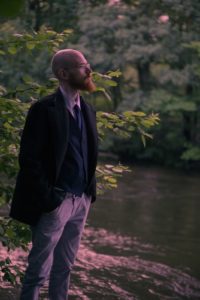LEEDS, U.K.: In a find that has stunned Shakespearean scholars and historians of the Elizabethan period, and which may shed new light on the mystery-shrouded life of the author of Hamlet and King John, a scholar at the University of Beckbirk in Leeds has uncovered what he believes is a fragment of a previously unknown Shakespeare sonnet.

The fragment was found tucked inside the ear trumpet of a traveling player of the Jacobean period, Quincy Cheeves, during a routine cleaning of Cheeves’s personal effects and accoutrements, on display at the Curiositie Museum in nearby Sheffield. The museum’s chief curator, Gwyneth Figgins, promptly turned over the nearly disintegrated and discolored paper fragment to Nigel Chetwynde-Steele, a reader in Elizabethan literature at Beckbirk.
Chetwynde-Steele, who painstakingly unfolded, cleaned, and photographed the fragment, not only postulated the link to Shakespeare but has speculated on the work’s date of composition.
“It seems clear to me that Shakespeare composed this sonnet while quarantined by the bubonic plague,” said Chetwynde-Steele. Indeed, while many have speculated that the pandemic-related theatre closure of 1606 is the period when the Bard wrote King Lear, Chetwynde-Steele posits that there’s an even stronger case for this new poem’s composition in that time—and the evidence is right on the page.
One line in the sonnet fragment, Chetwynde-Steele points out, refers clearly to “the third great year of James’ reign”—i.e., 1606—and another quatrain to the constraints of quarantine and to the dangers of an airborne disease:
When all Life’s shrunk unto a Chamber’s spanne,
And Brothers meet as Strangeres, Friend as Foe,
Suspicious glances pass ’twixt Man and Man,
For who beares Death-sweete Breath there’s Nonne can know
A later line deploring “remote Schoole” clearly seems quarantine-related, and a reference to “a Dearth of privie grass” cites a pandemic-related shortage of the Elizabethan equivalent of toilet paper. Chetwynde-Steele has even suggested that the poem only survives in this fragmentary form because Shakespeare was compelled to use the remainder of the paper to wipe himself.
Colleagues have expressed positive interest in Chetwynde-Steele’s claims, but insist that the fragment’s provenance has yet to be independently verified. One noted philologist, Dr. Esbeth Winkle of the University of Berkshire, has already chimed in to offer an alternative theory: that the fragment may have been in fact been authored by the Elizabethan poet Emilia Bassano.


